
Back at the time when gentle people going to San Francisco were sure to wear some flowers in their hair, a friend of mine, anti-war and pro-recycling, thought the funniest name of a musical group was Gladys Knight & The Pips. “Imagine going for an interview at Mellon or Alcoa,” he’d quip, “with a job application that said your main work experience was as a Pip.”
The group that’s currently in the running for the funniest name is Bernie and The Millennials, also able to fill concert venues, and complete with a leader who’s a self-declared socialist and a backup group that’s willing to risk sending the country into a full financial tailspin with a demonstrably flawed economic model historically in order to get some free tuition.
Tuition at public colleges and universities totals about $70 billion per year. Sanders’ plan calls for the federal government to pick up the tab for 67 percent of this cost, while the states would be required to fund the remaining 33 percent.
To qualify for federal funding, states are required to jump through a series of centrally-designed hoops, barriers, and hurdles erected by federal politicians and bureaucrats. Colleges and universities on the receiving end of federal giveaways in the Sanders program, for instance, are required to reduce their reliance on low-paid adjunct faculty, a pro-inflation edict. Additionally, no funding under the program could be used for the construction of non-academic buildings like sports stadiums or student centers.
Peculiarly, public colleges and universities receiving money from the Sanders’ tuition program (private colleges and universities are ineligible) are required to maintain their need-based tuition aid programs while no money under the Sanders’ giveaway program can be used to fund merit-based financial aid, a directive that seems designed to boost societal leveling by way of simultaneously rewarding neediness while penalizing superior academic performance.
To promote further leveling in the economy, Sanders’ aforementioned tuition aid program is to be fully paid for by imposing a Robin Hood tax on Wall Street.
In a macroeconomic sense of overall supply and demand, Millennials who’ve passed even an Economics-101 course should understand that free tuition in public colleges and universities will expand the supply of higher education students and job seekers while not increasing the number of job openings, a clear formula for a surplus of labor, higher unemployment and underemployment, and lower income growth for college and university graduates.
Just as politicians decided that too few Americans were homeowners and the answer was lower lending standards, a cosmetic solution that produced a surplus of sub-prime loans for sub-prime borrowers and an eventually bursting housing bubble that took down the borrowers who were the intended beneficiaries, Sen. Sanders free tuition concept is likely to have the unintended consequence of creating a bubble of over-supplied and underemployed college-educated labor.
In short, a free degree that puts someone in the unemployment line is about as valuable as a sub-prime loan that puts a house into foreclosure.
Bottom line, Sen. Sanders’ idea of “free” tuition in only public colleges and universities will radically undermine or demolish private sector colleges and universities, creating an unhealthy government monopoly that reduces competition, efficiency and diversity of thought in higher education. And the impact of the government calling all the shots in higher education? Warned George Orwell: “If you want a vision of the future, imagine a boot stamping on a human face — forever.”
Ralph R. Reiland is the B. Kenneth Simon professor of free enterprise and an associate professor of economics at Robert Morris University in Pittsburgh, and a columnist with the Pittsburgh Tribune-Review. Email him at [email protected].


